(完整版)国际经济学教案
- 格式:doc
- 大小:222.01 KB
- 文档页数:20
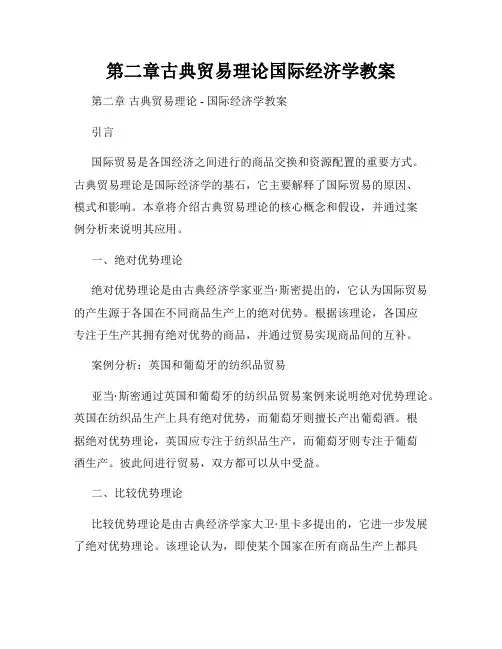
第二章古典贸易理论国际经济学教案第二章古典贸易理论 - 国际经济学教案引言国际贸易是各国经济之间进行的商品交换和资源配置的重要方式。
古典贸易理论是国际经济学的基石,它主要解释了国际贸易的原因、模式和影响。
本章将介绍古典贸易理论的核心概念和假设,并通过案例分析来说明其应用。
一、绝对优势理论绝对优势理论是由古典经济学家亚当·斯密提出的,它认为国际贸易的产生源于各国在不同商品生产上的绝对优势。
根据该理论,各国应专注于生产其拥有绝对优势的商品,并通过贸易实现商品间的互补。
案例分析:英国和葡萄牙的纺织品贸易亚当·斯密通过英国和葡萄牙的纺织品贸易案例来说明绝对优势理论。
英国在纺织品生产上具有绝对优势,而葡萄牙则擅长产出葡萄酒。
根据绝对优势理论,英国应专注于纺织品生产,而葡萄牙则专注于葡萄酒生产。
彼此间进行贸易,双方都可以从中受益。
二、比较优势理论比较优势理论是由古典经济学家大卫·里卡多提出的,它进一步发展了绝对优势理论。
该理论认为,即使某个国家在所有商品生产上都具有绝对优势,贸易仍然能够带来双方的收益。
比较优势是基于生产成本的概念,即一个国家在生产某种商品上所付出的机会成本较低。
案例分析:美国和中国的贸易以美国和中国之间的贸易为例,假设美国在所有商品生产上都具有绝对优势。
然而,根据比较优势理论,中国仍然可以通过专注于自身相对较低机会成本的商品生产,如劳动密集型产品,来与美国进行贸易。
这种贸易有助于实现资源的高效配置,同时使双方都能获得经济利益。
三、要素比较优势理论要素比较优势理论是在比较优势理论基础上发展起来的,它强调不同国家间生产要素的差异性。
根据该理论,贸易将主要发生在生产要素相对丰富的国家和要素相对稀缺的国家之间。
这一理论在解释资本、劳动、技术等生产要素的国际流动方面具有重要意义。
案例分析:德国和中国的汽车贸易以德国和中国之间的汽车贸易为例,假设德国拥有先进的汽车制造技术和高度发达的资本市场,而中国则拥有廉价的劳动力资源。

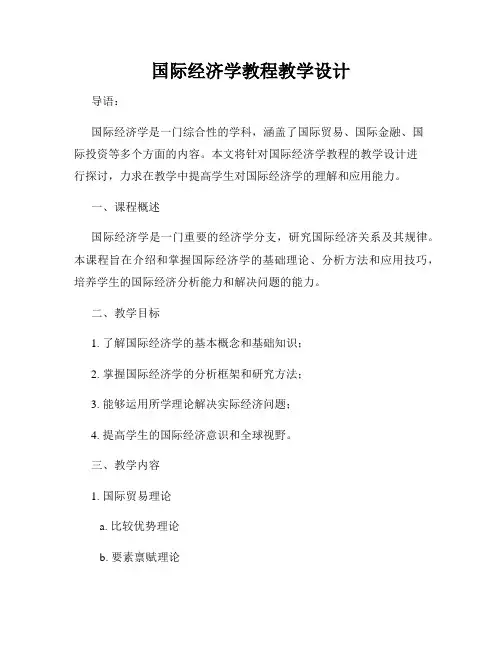
国际经济学教程教学设计导语:国际经济学是一门综合性的学科,涵盖了国际贸易、国际金融、国际投资等多个方面的内容。
本文将针对国际经济学教程的教学设计进行探讨,力求在教学中提高学生对国际经济学的理解和应用能力。
一、课程概述国际经济学是一门重要的经济学分支,研究国际经济关系及其规律。
本课程旨在介绍和掌握国际经济学的基础理论、分析方法和应用技巧,培养学生的国际经济分析能力和解决问题的能力。
二、教学目标1. 了解国际经济学的基本概念和基础知识;2. 掌握国际经济学的分析框架和研究方法;3. 能够运用所学理论解决实际经济问题;4. 提高学生的国际经济意识和全球视野。
三、教学内容1. 国际贸易理论a. 比较优势理论b. 要素禀赋理论c. 新贸易理论d. 外国投资与跨国公司2. 国际金融理论a. 汇率理论与汇率制度b. 国际支付与清算c. 国际资本流动d. 国际金融市场与金融机构3. 国际投资理论a. 跨国直接投资理论b. 国际投资环境与政策c. 跨国公司的国际化策略d. 外商直接投资的影响效应4. 国际经济政策a. 贸易政策与关税b. 货币政策与汇率管理c. 投资政策与产业政策d. 双边与多边经济合作四、教学方法1. 理论讲授:通过讲授国际经济学的基础理论,帮助学生建立起系统的学科知识框架,理解和把握国际经济学的基本概念和原理。
2. 案例分析:选取一些实际国际经济问题作为案例,通过分析和讨论,激发学生的思考和学习兴趣,提高他们运用理论解决问题的能力。
3. 小组讨论:鼓励学生在小组内互相讨论和交流,共同解决实际经济问题,培养团队合作和沟通能力。
4. 实地考察:安排学生前往国际贸易、金融机构等实地考察,亲身感受国际经济的运作和发展,加深对理论知识的理解和应用。
五、教学评价1. 平时表现:包括课堂参与、作业完成等因素,通过平时表现来对学生的学习态度和实际掌握程度进行评估。
2. 期中考试:考查学生对国际经济学基本概念和理论的理解和掌握程度。
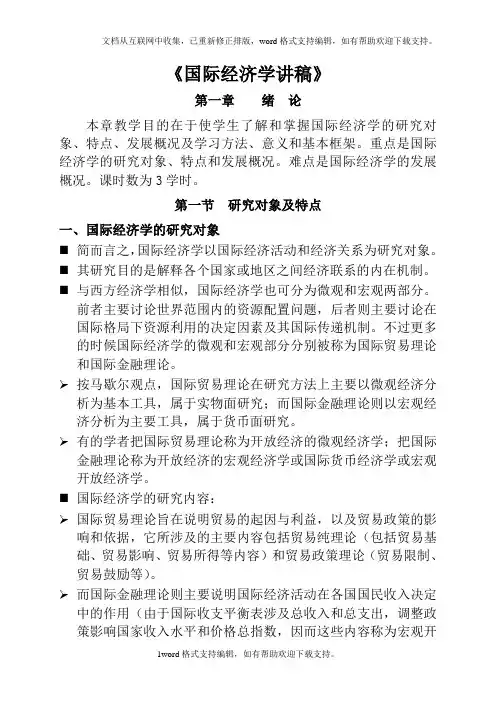
《国际经济学讲稿》第一章绪论本章教学目的在于使学生了解和掌握国际经济学的研究对象、特点、发展概况及学习方法、意义和基本框架。
重点是国际经济学的研究对象、特点和发展概况。
难点是国际经济学的发展概况。
课时数为3学时。
第一节研究对象及特点一、国际经济学的研究对象⏹简而言之,国际经济学以国际经济活动和经济关系为研究对象。
⏹其研究目的是解释各个国家或地区之间经济联系的内在机制。
⏹与西方经济学相似,国际经济学也可分为微观和宏观两部分。
前者主要讨论世界范围内的资源配置问题,后者则主要讨论在国际格局下资源利用的决定因素及其国际传递机制。
不过更多的时候国际经济学的微观和宏观部分分别被称为国际贸易理论和国际金融理论。
➢按马歇尔观点,国际贸易理论在研究方法上主要以微观经济分析为基本工具,属于实物面研究;而国际金融理论则以宏观经济分析为主要工具,属于货币面研究。
➢有的学者把国际贸易理论称为开放经济的微观经济学;把国际金融理论称为开放经济的宏观经济学或国际货币经济学或宏观开放经济学。
⏹国际经济学的研究内容:➢国际贸易理论旨在说明贸易的起因与利益,以及贸易政策的影响和依据,它所涉及的主要内容包括贸易纯理论(包括贸易基础、贸易影响、贸易所得等内容)和贸易政策理论(贸易限制、贸易鼓励等)。
➢而国际金融理论则主要说明国际经济活动在各国国民收入决定中的作用(由于国际收支平衡表涉及总收入和总支出,调整政策影响国家收入水平和价格总指数,因而这些内容称为宏观开放经济学),以及各种国内经济活动对国际经济关系的影响。
其主要内容包括外汇理论与政策、国际收支调整理论与政策及国际货币制度等。
当然,国际经济学的研究内容在不断深化和发展。
➢保罗·克鲁格曼认为,主权国家之间的经济交往所引发的种种问题构成了国际经济学研究的主体。
其主题有七大:●贸易所得●贸易模式●贸易保护●国际收支平衡●汇率决定●国际间政策协调●国际资本市场二、特点⏹研究对象的特点——以国际经济关系为研究对象。
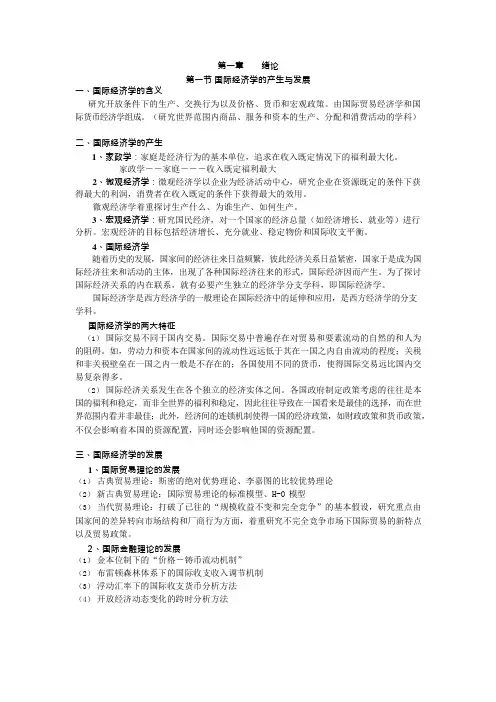
一、国际经济学的含义第一章绪论第一节国际经济学的产生与发展研究开放条件下的生产、交换行为以及价格、货币和宏观政策。
由国际贸易经济学和国际货币经济学组成。
(研究世界范围内商品、服务和资本的生产、分配和消费活动的学科)二、国际经济学的产生1、家政学:家庭是经济行为的基本单位,追求在收入既定情况下的福利最大化。
家政学――家庭―――收入既定福利最大2、微观经济学:微观经济学以企业为经济活动中心,研究企业在资源既定的条件下获得最大的利润,消费者在收入既定的条件下获得最大的效用。
微观经济学着重探讨生产什么、为谁生产、如何生产。
3、宏观经济学:研究国民经济,对一个国家的经济总量(如经济增长、就业等)进行分析。
宏观经济的目标包括经济增长、充分就业、稳定物价和国际收支平衡。
4、国际经济学随着历史的发展,国家间的经济往来日益频繁,彼此经济关系日益紧密,国家于是成为国际经济往来和活动的主体,出现了各种国际经济往来的形式,国际经济因而产生。
为了探讨国际经济关系的内在联系,就有必要产生独立的经济学分支学科,即国际经济学。
国际经济学是西方经济学的一般理论在国际经济中的延伸和应用,是西方经济学的分支学科。
国际经济学的两大特征(1)国际交易不同于国内交易。
国际交易中普遍存在对贸易和要素流动的自然的和人为的阻碍。
如,劳动力和资本在国家间的流动性远远低于其在一国之内自由流动的程度;关税和非关税壁垒在一国之内一般是不存在的;各国使用不同的货币,使得国际交易远比国内交易复杂得多。
(2)国际经济关系发生在各个独立的经济实体之间。
各国政府制定政策考虑的往往是本国的福利和稳定,而非全世界的福利和稳定,因此往往导致在一国看来是最佳的选择,而在世界范围内看并非最佳;此外,经济间的连锁机制使得一国的经济政策,如财政政策和货币政策,不仅会影响着本国的资源配置,同时还会影响他国的资源配置。
三、国际经济学的发展1、国际贸易理论的发展(1)古典贸易理论:斯密的绝对优势理论、李嘉图的比较优势理论(2)新古典贸易理论:国际贸易理论的标准模型、H-O 模型(3)当代贸易理论:打破了已往的“规模收益不变和完全竞争”的基本假设,研究重点由国家间的差异转向市场结构和厂商行为方面,着重研究不完全竞争市场下国际贸易的新特点以及贸易政策。
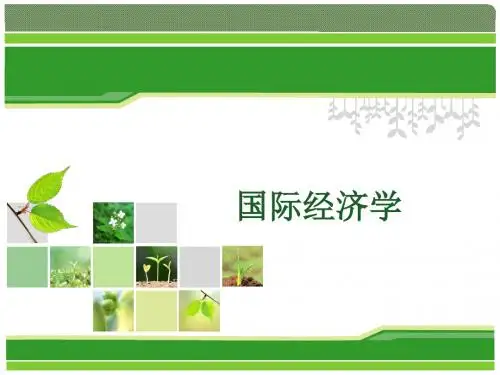
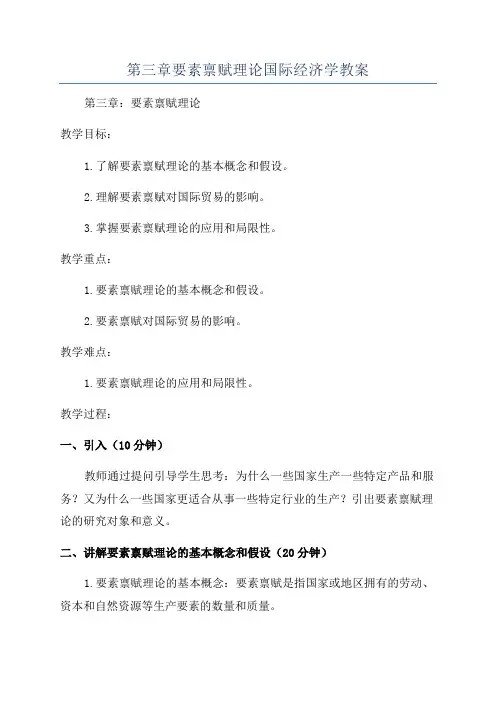
第三章要素禀赋理论国际经济学教案第三章:要素禀赋理论教学目标:1.了解要素禀赋理论的基本概念和假设。
2.理解要素禀赋对国际贸易的影响。
3.掌握要素禀赋理论的应用和局限性。
教学重点:1.要素禀赋理论的基本概念和假设。
2.要素禀赋对国际贸易的影响。
教学难点:1.要素禀赋理论的应用和局限性。
教学过程:一、引入(10分钟)教师通过提问引导学生思考:为什么一些国家生产一些特定产品和服务?又为什么一些国家更适合从事一些特定行业的生产?引出要素禀赋理论的研究对象和意义。
二、讲解要素禀赋理论的基本概念和假设(20分钟)1.要素禀赋理论的基本概念:要素禀赋是指国家或地区拥有的劳动、资本和自然资源等生产要素的数量和质量。
2.要素禀赋理论的假设:要素禀赋理论假设生产要素在国际间无阻碍流动,市场完全竞争,生产要素禀赋差异是国与国之间贸易和投资的主要原因。
三、讲解要素禀赋对国际贸易的影响(30分钟)1.比较优势和绝对优势:根据要素禀赋理论,拥有相对丰富要素的国家具有比较优势,而拥有绝对丰富要素的国家则具有绝对优势。
2.要素禀赋支配型贸易:高度要素禀赋差异的国家间通过国际贸易分工实现互利互补。
丰富劳动力的国家更适合生产劳动密集型产品,而丰富资本的国家更适合生产资本密集型产品。
3.要素价格均等化:要素禀赋理论认为,不同国家的要素价格将在国际市场上趋于相等,从而减少要素禀赋差异的影响。
四、讲解要素禀赋理论的应用和局限性(30分钟)1.要素禀赋理论的应用:要素禀赋理论可以解释国际贸易分工的发展趋势,指导国际投资和产业政策的制定。
2.要素禀赋理论的局限性:要素禀赋理论忽视了其他因素对国际贸易的影响,如技术进步和政府政策。
此外,要素禀赋理论还不能解释一些特殊情况下的贸易模式,如同质要素禀赋差异下的贸易。
五、总结与提问(10分钟)教师总结要素禀赋理论的要点,并提问学生:你觉得要素禀赋理论在解释国际贸易方面有哪些优点和局限性?六、作业(5分钟)布置相关阅读任务:阅读关于要素禀赋理论的经济学论文或案例研究,并撰写作业报告。

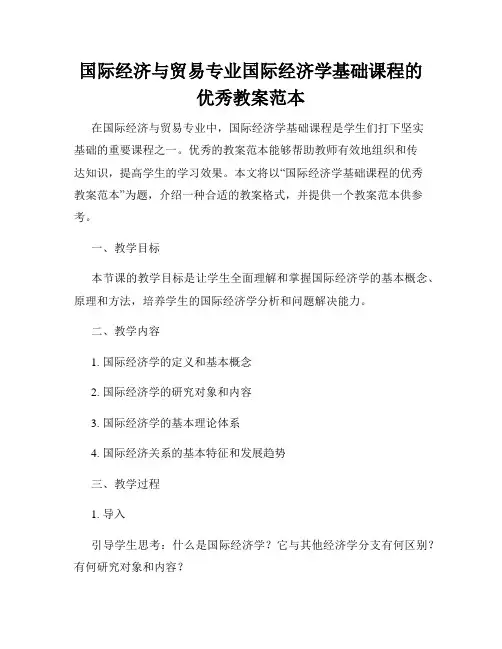
国际经济与贸易专业国际经济学基础课程的优秀教案范本在国际经济与贸易专业中,国际经济学基础课程是学生们打下坚实基础的重要课程之一。
优秀的教案范本能够帮助教师有效地组织和传达知识,提高学生的学习效果。
本文将以“国际经济学基础课程的优秀教案范本”为题,介绍一种合适的教案格式,并提供一个教案范本供参考。
一、教学目标本节课的教学目标是让学生全面理解和掌握国际经济学的基本概念、原理和方法,培养学生的国际经济学分析和问题解决能力。
二、教学内容1. 国际经济学的定义和基本概念2. 国际经济学的研究对象和内容3. 国际经济学的基本理论体系4. 国际经济关系的基本特征和发展趋势三、教学过程1. 导入引导学生思考:什么是国际经济学?它与其他经济学分支有何区别?有何研究对象和内容?2. 知识讲解分步骤介绍国际经济学的定义、基本概念、研究对象和内容。
通过案例分析,逐步深入学生对国际经济学的理解。
3. 理论讲解详细讲解国际经济学的基本理论体系,包括国际贸易理论、国际货币理论、国际金融理论等。
通过图表和实例,形象生动地呈现理论内容。
4. 知识拓展向学生介绍国际经济关系的基本特征和发展趋势,引导学生思考国际经济发展的环境和挑战。
5. 练习与讨论组织学生进行个人或小组练习,巩固所学知识。
随后进行整体讨论,让学生相互交流并分享答案、心得和问题。
6. 总结与延伸对本节课的内容进行总结,并提出延伸问题和思考。
鼓励学生进行自主学习和进一步探索。
四、教学工具和资源黑板、彩色粉笔、投影仪、PPT等。
五、教学评价根据学生练习和讨论的表现,进行参与度和理解程度的综合评价。
并鼓励学生提交作业,进行系统的个人评价和自我提高。
六、教学反思通过教学反思,不断完善和改进教学方法,提高教学效果。
教案范本的目的是为了提供教师教学活动的指导和学生学习的参考。
教师可以根据教案自行调整和改进课堂内容和教学方法,以适应不同的教学需求和学生特点。
通过该教案范本,教师可以从教学目标、教学内容、教学过程、教学工具和资源、教学评价等方面进行有效的组织和安排。
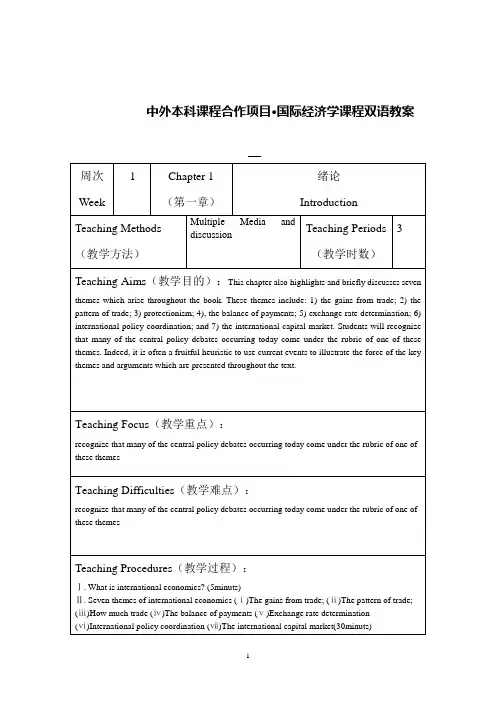
中外本科课程合作项目·国际经济学课程双语教案Chapter One第一章Introduction 绪论Unit 1 Themes of international economics section1(国际经济学的研究对象1)Step 1 Lead-in 新课导入( 10 Minutes)What is international economics?Step 2 New Class Content新课内容( 20Minutes)Twp of Seven themes of international economics (ⅰ)The gains from trade; (ⅱ)The pattern of trade;Step 3 Practice 实践活动( 10 Minutes)Group discussionStep 4 Summary总结( 10 Minutes)The main two parts of International Economics: trade and money (i)Two Subfields 1. International trade; 2.International money (ii) The relationship between international trade and international moneyUnit 2 Themes of international economics section2(国际经济学的研究对象2)Step 1 Lead-in 新课导入( 10 Minutes)What is the balance of payment?Step 2 New Class Content新课内容( 20Minutes)Two of seven themes of international economics (ⅲ)How much trade (ⅳ)The balance of paymentsStep 3 Practice 实践活动( 10 Minutes)Group discussionStep 4 Summary总结( 10 Minutes)The main two parts of International Economics: trade and money (i)Two Subfields 1. International trade; 2.International money (ii) The relationship between international trade and international moneyUnit 3Themes of international economics section3(国际经济学的研究对象3)Step 1 Lead-in 新课导入( 10 Minutes)What is international economics?Step 2 New Class Content新课内容( 20Minutes)The last themes of international economics (ⅴ)Exchange rate determination(ⅵ)International policy coordination (ⅶ)The international capital marketStep 3 Practice 实践活动( 10 Minutes)Group discussionStep 4 Summary总结( 10 Minutes)The main two parts of International Economics: trade and money (i)Two Subfields 1. International trade; 2.International money (ii) The relationship between international trade and international money英文课程名称Chapter TwoLABOR PRODUCTIVITY AND COMPARATIVE ADV ANTAGE: THE RICARDIAN MODEL(生产率和李嘉图模型)Unit 1comparative advantage(绝对优势)Step 1 Review 复习( 5 Minutes)Seven themes of international economics (ⅰ)The gains from trade; (ⅱ)The pattern of trade; (ⅲ)How much trade (ⅳ)The balance of payments (ⅴ)Exchange rate determination(ⅵ)International policy coordination (ⅶ)The international capital marketStep 2 Lead-in 新课导入( 10 Minutes)1.What's the comparative advantage?Step 3 New Class Content 新课内容( 85 Minutes)The concept of comparative advantage (i) Opportunity cost (ii)A numerical example (iii)What's comparative advantage If the opportunity cost of producing a goods in terms of other goods is lower in a country than it is in other country, then a country has a comparative advantage in producing that goods.Step 4 Practice 实践活动(30Minutes)Group discussionStep 5 Summary总结( 20 Minutes)The Ricardian model provides an introduction to international trade theory. This most basic model of trade involves two countries, two goods, and one factor of production, labor. Differences in relative labor productivity across countries give rise to international trade. This Ricardian model, simple as it is, generates important insights concerning comparative advantage and the gains from trade. These insights are necessary foundations for the more complex models presented in later chapters.The text exposition begins with the examination of the production possibility frontier and the relative prices of goods for one country. The production possibility frontier is linear because of the assumption of constant returns to scale for labor, the sole factor of production. The opportunity cost of one good in terms of the other equals the price ratio since prices equal costs, costs equal unit labor requirements times wages, and wages are equal in each industry.Unit 2Step 1 Review 复习( 5 Minutes)The concept of comparative advantageStep 2 Lead-in 新课导入( 10 Minutes)How to describe the Ricardian model?Step 3 New Class Content 新课内容( 85 Minutes)A one-factor economy(i)Assumptions (ii) Production possibilities (iii)Relative prices and supply.Trade in a one-factor world(ⅰ)Determining the relative price after trade 1. Relative demand curve 2. Relative supply curve 3. The world general equilibrium In the Ricardian model, countries will export goods that their labor produces relatively efficiently and import goods that their labor produces relatively inefficiently. (ⅱ)The gains from trade 1.The numerical example2.Two ways to examine the gains from trade (ⅲ)Relative wagesStep 4 Practice 实践活动(30Minutes)Group discussionStep 5 Summary总结( 20 Minutes)The text exposition begins with the examination of the production possibility frontier and the relative prices of goods for one country. The production possibility frontier is linear because of the assumption of constant returns to scale for labor, the sole factor of production. The opportunity cost of one good in terms of the other equals the price ratio since prices equal costs, costs equal unit labor requirements times wages, and wages are equal in each industry.Unit 3Step 1 Review 复习( 5 Minutes)Trade in a one-factor worldStep 2 Lead-in 新课导入( 10 Minutes).How to determine pattern of trade in the Ricardian model?Step 3 New Class Content 新课内容( 85 Minutes)Misconceptions about comparative advantage (ⅰ)Productivity and competitiveness (ⅱ)The pauper labor argument (ⅲ)ExploitationComparative advantage with many goods (i) Setting up the model (ii)Relative wage and specialization 1. The rule for allocating world production 2. The benefits from specialization (iii) Determine the relative wage in the multigoods model 1. The relative demand for labor 2. Relative supply of labor 3. Determination of relative wagesⅥ.Adding transport costs and nontraded goodsStep 4 Practice 实践活动(30Minutes)Group discussionStep 5 Summary总结( 20 Minutes)After defining these concepts for a single country, a second country is introduced which has different relative unit labor requirements. General equilibrium relative supply and demand curves are developed. This analysis demonstrates that at least one country will specialize in production. The gains from trade are then demonstrated with a graph and a numerical example. The intuition of indirect production, that is "producing" a good by producing the good for which a country enjoys a comparative advantage and then trading for the other good, is an appealing concept to emphasize when presenting the gains from trade argument. Students are able to apply the Ricardian theory of comparative advantage to analyze three misconceptions about the advantages of free trade. Each of the three "myths" represents a common argument against free trade and the flaws of each can be demonstrated in the context of examples already developed in the chapter.While the initial intuitions are developed in the context of a two good model, it is straightforward to extend the model to describe trade patterns when there are N goods. This analysis can be used to explain why a small country specializes in the production of a few goods while a large country specializes in the production of many goods. The chapter ends by discussing the role that transport costs play in making some goods non-traded.英文课程名称Chapter ThreeS pecific Factors and Income Distribution(特定要素模型)Unit 1第一节Step 1 Review 复习( 5 Minutes)Ricardian modelStep 2 Lead-in 新课导入( 10 Minutes)Do Land owners support the free trade policy when land is specific to the import-competingsector?Step 3 New Class Content 新课内容( 20 Minutes)The Specific Factors ModelAssumptions of the ModelBox: What is a Specific Factor?Production PossibilitiesPrices, Wages, and Labor AllocationRelative Prices and the Distribution of IncomeIStep 4 Practice 实践活动(10 Minutes)Group discussionStep 5 Summary总结( 5 Minutes)he analysis presented in the previous chapter, demonstrating unambiguous gains from trade, may leave students wondering why free trade is such a politically charged issue and why protectionism is so heatedly discussed in the press. The reason for this is that the debates concerning free trade focus on its distributional rather than its efficiency effects. A formal examination of these effects requires a model which has factors of production linked to producing certain goods. Two models of this nature are presented in this chapter.The first model includes factors of production which are inexorably tied to producing one and only one good. The particular example presented in the text involves winemakers and cheesemakers. The immobility of labor prevents equalization of wages. The production possibility frontier of this economy is a rectangle and the relative supply curve is a vertical line. An equilibrium relative price can be determined when the relative demand curve is specified.Consider the effect of introducing another country which can produce the same bundle of goods. The second economy shares the same production technology, but has different relative amounts of each type of labor. Trade between these two economies benefits each in the aggregate since the possible consumption set of each country expands. However, distributional issues arise when trade is permitted since workers in particular sectors may not gain from trade. There will be no gain for the labor in each economy which was relatively scarce prior to trade as compared to after trade. The type of labor relatively abundant in a country will gain from trade. The source of this effect is the movement in relative prices which favors the good which was relatively abundant in each country before trade. The general outcome is that trade benefits workers in the export sector of each country and hurts workers in the import-competing sector.Unit 2第二节Step 1 Review 复习( 5 Minutes)Ricardian modelStep 2 Lead-in 新课导入( 10 Minutes)Describe the specific factor model.Step 3 New Class Content 新课内容( 20 Minutes)International Trade in the Specific Factors ModelResources and Relative SupplyTrade and Relative PricesThe Pattern of TradeIncome Distribution and the Gains From TradeStep 4 Practice 实践活动(10 Minutes)Group discussionStep 5 Summary总结( 5 Minutes)Next, a more general model is presented to investigate the distributional effects of trade. This specific factors model allows an examination of the distributional effects of trade on factors inexorably tied to the production of a specific good as well as on a factor that can be used to produce either good. The three factors in this model include two specific factors, land and capital, as well as one inter-sectorally mobile factor, labor. The fixed amount of each specific factor results in diminishing returns to labor. The mobility of labor ensures an equal wage in the production of either good, and perfect competition ensureUnit 3第3节Step 1 Review 复习( 5 Minutes)Ricardian modelStep 2 Lead-in 新课导入( 10 Minutes)Do Land owners support the free trade policy when land is specific to the import-competing sector?Step 3 New Class Content 新课内容( 20 Minutes)The Political Economy of Trade: A Preliminary ViewOptimal Trade PolicyBox: Specific Factors and the Beginnings of Trade TheoryIncome Distribution and Trade PoliticsStep 4 Practice 实践活动(10 Minutes)(内容5号Times New Roman)Step 5 Summary总结( 5 Minutes)The models presented in this chapter provide a framework for a preliminary discussion of the political economy of trade. The general support for free trade among economists despite its income distributional effects is justified. One reason for this support is that the benefits of free trade are widely dispersed while its costs are concentrated. Economists may better serve the country as advocates for the general welfare since there is no shortage of advocates for particular groups injured by trade. The issue of the political economy of trade reappears throughout the book. An appendix provides further details on the specific factors mode.英文课程名称Chapter fourRESOURCES AND TRADE: THE HECHSCHER-OHLINMODEL(H-O定理)Unit 1第一节Step 1 Review 复习( 5 Minutes)The specific factors modelStep 2 Lead-in 新课导入( 10 Minutes)What is model of a Two-Factor Economy?Step 3 New Class Content 新课内容(70 Minutes)Ⅰ.A Model of a Two-Factor Economy (ⅰ)Assumptions of the Model ⅱ)Factor Prices and Goods Prices 1.The relationship between w/r and PC/PF 2.From PC/PF to T/L 3.Relative price and income distribution (ⅲ)Resources and Output 1.The allocation of resources 2.Resources change and outputs changeStep 4 Practice 实践活动( 10 Minutes)Group discussionStep 5 Summary总结( 5 Minutes)In Chapter 4, the Heckscher-Ohlin theory considers the pattern of production and trade which will arise when countries have different endowments of factors of production, such as labor, capital, and land. The basic point is that countries tend to export goods that are intensive in the factors with which they are abundantly supplied. Trade has strong effects on the relative earnings of resources, and tends to lead to equalization across countries of prices of the factors of production. These theoretical results and related empirical findings are presented in this chapter.Unit 2第二节Step 1 Review 复习( 5 Minutes)1.Describe the pattern of trade under H-O model.Step 2 Lead-in 新课导入( 10 Minutes)What's the income distribution effect of trade under H-O model?Step 3 New Class Content 新课内容(70 Minutes)Ⅱ.Effects of International Trade Between Two-Factor Economies (ⅰ)Relative Prices and the Pattern of Trade 1.Assumption 2.Relative supply for 2 countries and relative price of cloth in 2 countries 3.The pattern of trade Home is labor-abundant and foreign is land-abundant, So Home exports labor-intensive goods, Foreign exports land-intensive goods. (ⅱ)Trade and the Distribution of Income 1.Income distribution effect Owners of a country's abundant factors gain from trade while owners of a country's scarce factors lose. 2.Comparing the income distribution effects of trade of 2 models (ⅲ)Factor Price Equalization 1.Factor-price Equalization Theorem Home and Foreign have the same wage rate and rent on land when they trade with each other. 2.The difference between theory and realityStep 4 Practice 实践活动( 10 Minutes)Group discussionStep 5 Summary总结( 5 Minutes)The chapter begins by developing a general equilibrium model of an economy with two goods which are each produced using two factors according to fixed coefficient production functions. The assumption of fixed coefficient production functions provides an unambiguous ranking of goods in terms of factor intensities. (The appendix develops the model when the production functions have variable coefficients.) Two important results are derived using this model. The first is known as the Rybczynski effect. Increasing the relative supply of one factor, holding relative goods prices constant, leads to a biased expansion of production possibilities favoring the relative supply of the good which uses that factor intensively.The second key result is known as the Stolper-Samuelson effect. Increasing the relative price of a good, holding factor supplies constant, increases the return to the factor used intensively in the production of that good by more than the price increase, while lowering the return to the other factor. This result has important income distribution implications.It can be quite instructive to think of the effects of demographic/ labor force changes on the supply of different products. For example, how might the pattern of production during the productive years of the "Baby Boom" generation differ from the pattern of production for post Baby Boom generations. What does this imply for returns to factors and relative price behavior?The central message concerning trade patterns of the Heckscher-Ohlin theory is that countries tend to export goods whose production is intensive in factors with which they are relatively abundantly endowed. This is demonstrated by showing that, using the relative supply and relative demand analysis introduced in Chapter 2, the country relatively abundantly endowed with a certain factor will produce that factor more cheaply than the other country. International trade leads to a convergence of goods prices. Thus, the results from the Stolper-Samuelson Theory demonstrate that owners of a country's abundant factors gain from trade but owners of a country's scarce factors lose. The extension of this result is the important Factor Price Equalization Theorem, which states that trade in (and thus price equalization of) goods leads to an equalization in the rewards to factors across countries. The political implications of factor price equalization should be interesting to students.Unit 3第3节Step 1 Review 复习( 5 Minutes)Effects of International Trade Between Two-Factor Economies\Step 2 Lead-in 新课导入( 10 Minutes)How to explain The Leotief Paradox?Step 3 New Class Content 新课内容(70 Minutes)Ⅲ. Empirical evidence on H-O Model (i)The Leotief Paradox (ii) Other tests on H-O model Step 4 Practice 实践活动( 10 Minutes)Group discussionStep 5 Summary总结( 5 Minutes) IEmpirical results concerning the Heckscher-Ohlin theory, beginning with the Leontief paradox and extending to current research, do not support its predictions concerning resource endowments explaining patterns of trade. This observation has motivated many economists to consider motives for trade between nations that are not exclusively based on differences across countries. These concepts will be explored in later chapters. Despite these shortcomings, important and relevant results concerning income distribution are obtained from the Heckscher-Ohlin theory.英文课程名称Chapter FiveTHE STANDARD TRADE MODEL(标准贸易模型)Unit 1第1节Step 1 Review 复习( 5 Minutes)H-O ModelStep 2 Lead-in 新课导入( 10 Minutes)What's terms of trade?Step 3 New Class Content 新课内容(20 Minutes)Ⅰ.A Standard Model of a Trading Economy (ⅰ)Production Possibilities and Relative Supply 1.Isovalue line 2.The production point and the relative supply (ⅱ)Relative Prices and Demand 1.The relationship among production, consumption and trade 2.The relative price and the relative demand (ⅲ)The Welfare Effect of Changes in the Terms of Trade(ⅳ)Determining Relative PricesStep 4 Practice 实践活动( 10 Minutes)Group discussionStep 5 Summary总结( 5 Minutes)The standard trade model is based upon four relationships. First, an economy will produce at the point where the production possibilities curve is tangent to the relative price line (called the isovalue line). Second, indifference curves describe the tastes of an economy and the consumption point for that economy is found at the tangency of the budget line and the highest indifference curve. These two relationships yield the familiar general equilibrium trade diagram for a small economy (one which takes as given the terms of trade) where the consumption point and production point are the tangencies of the isovalue line with the highest indifference curve and the production possibilities frontier, respectively.You may want to work with this standard diagram to demonstrate a number of basic points. First, an autarkic economy must produce what it consumes, which determines the equilibrium price ratio; and second, opening an economy to trade shifts the price ratio line and unambiguously increases welfare. Third, an improvement in the terms of trade increases welfare in the economy. Fourth, it is straightforward to move from a small country analysis to a two country analysis by introducing a structure of world relative demand and supply curves which determine relative prices.These relationships can be used in conjunction with the Rybczynski and the Stolper-Samuelson Theorems from the previous chapter to address a range of issues. For example, you can consider whether the dramatic economic growth of countries like Japan and Korea has helped or hurt the United States as a whole, and also identify the classes of individuals within the United States who have been hurt by the particular growth biases of these countries. In teaching these points, it might be interesting and useful to relate them to current events. For example, you can lead a class discussion of the implications for the United States of the provision of forms of technical and economic assistance to the emerging economies around the world or the ways in which a world recession can lead to a fall in demand for U.S. export goods.The example provided in the text considers the popular arguments in the media that growth in Japan or Korea hurts the United States. The analysis presented in this chapter demonstrates thatthe bias of growth is important in determining welfare effects rather than the country in which growth occurs. The existence of biased growth, and the possibility of immiserizing growth is discussed. The Relative Supply (RS) and Relative Demand (RD) curves illustrate the effect of biased growth on the terms of trade. The new terms of trade line can be used with the general equilibrium analysis to find the welfare effects of growth. A general principle which emerges is that a country which experiences export-biased growth will have a deterioration in its terms of trade while a country which experiences import-biased growth has an improvement in its terms of trade. A case study points out that growth in the rest of the world has made other countries more like the United States. This import-biased growth has worsened the terms of trade for the United States.Unit 2第2节Step 1 Review 复习( 5 Minutes).A Standard Model of a Trading EconomyStep 2 Lead-in 新课导入( 10 Minutes)Discuss the terms of trade in China when cloth-biased growth happens in any country. Step 3 New Class Content 新课内容(20 Minutes)Ⅱ.Economic Growth: A Shift of the RS Curve (ⅰ)Growth and the Production Possibility Frontier Export-biased growth and import-biased growth (ⅱ)Relative Supply and the Terms of Trade (ⅲ)International Effects of Growth 1.Biased growth and effects of trade 2.Immiserizing GrowthStep 4 Practice 实践活动( 10 Minutes)Group discussionStep 5 Summary总结( 5 Minutes)The second issue addressed in the context of the standard trade model is the effects of international transfers. The salient point here is the direction, if any, in which the relative demand curve shifts in response to the redistribution of income from a transfer. A transfer worsens the donor's terms of trade if it has a higher marginal propensity to consume its export good than the recipient. The presence of non-traded goods tends to reinforce the deterioration of terms of trade for the donor country. The case study attendant to this issue involves the deterioration of many Asian countries’ terms of trade due to the large capital withdrawals at the end of the 1990s.Unit 3第3节Step 1 Review 复习( 5 Minutes)the effects of international transfers.Step 2 Lead-in 新课导入( 10 Minutes)How is the terms of trade for a large country when this country imposes a tariff?Step 3 New Class Content 新课内容(20 Minutes)Ⅲ.International Transfers of Income: Shifting the RD Curve (ⅰ)The Transfer Problem Debate on The international transfer (ⅱ)Effects of a Transfer on the Terms of Trade 1. International Transfer of income and the Shift in RD 2. A transfer worsens donor's terms of trade 3.A transfer improves the donor's terms of trade (ⅲ)Presumptions about the Terms of Trade Effects of Transfers Ⅳ.Tariffs and Export Subsidies: Simultaneous Shifts in RS and RD (ⅰ)Relative Demand and Supply Effects of a Tariff 1. External prices and internal prices 2. Tariff and RS 3. Tariff and RD 4. Tariff and the terms of trade Home's terms of trade improve at Foreign's expense when Home impose a tariff. And this effect depends on how large the country imposing the tariff is relative to the rest of the world. (ⅱ)Effects of an Export Subsidy A home export subsidy worsens home's terms of trade and improves foreign's. (ⅲ)Implications of Terms of Trade EffectsStep 4 Practice 实践活动( 10 Minutes)Group discussionStep 5 Summary总结( 5 Minutes)The third area to which the standard trade model is applied are the effects of tariffs and export subsidies on welfare and terms of trade. The analysis proceeds by recognizing that tariffs or subsidies shift both the relative supply and relative demand curves. A tariff on imports improves the terms of trade, expressed in external prices, while a subsidy on exports worsens terms of trade. The size of the effect depends upon the size of the country in the world. Tariffs and subsidies also impose distortionary costs upon the economy. Thus, if a country is large enough, there may be an optimum, non-zero tariff. Export subsidies, however, only impose costs upon an economy. Intranationally, tariffs aid import-competing sectors and hurt export sectors while subsidies have the opposite effect. An appendix presents offer curve diagrams and explains this mode of analysis.英文课程名称Chapter 6ECONOMIES OF SCALE, IMPERFECT COMPETITION,AND INTERNATIONAL(规模经济和不完全竞争)Unit 1第一节Step 1 Review 复习( 5 Minutes)Standard modelStep 2 Lead-in 新课导入( 10 Minutes)What's terms of trade?Step 3 New Class Content 新课内容(20 Minutes)Economies of Scale and International Trade: An OverviewEconomies of Scale and Market StructureThe Theory of Imperfect CompetitionMonopoly: A Brief ReviewMonopolistic CompetitionLimitations of the Monopolistic Competition ModelStep 4 Practice 实践活动( 10 Minutes)Group discussionStep 5 Summary总结( 5 Minutes)In previous chapters, trade between nations was motivated by their differences in factor productivity or relative factor endowments. The type of trade which occurred, for example of food for manufactures, is based on comparative advantage and is called interindustry trade. This chapter introduces trade based on economies of scale in production. Such trade in similar productions is called intraindustry trade, and describes, for example, the trading of one type of manufactured good for another type of manufactured good. It is shown that trade can occur when there are no technological or endowment differences, but when there are economies of scale or increasing returns in production.Economies of scale can either take the form of 1) external economies whereby the cost per unit depends on the size of the industry but not necessarily on the size of the firm; or as 2) internal economies, whereby the production cost per unit of output depends on the size of the individual firm but not necessarily on the size of the industry. Internal economies of scale give rise to imperfectly competitive markets, unlike the perfectly competitive market structures that were assumed to exist in earlier chapters. This motivates the review of models of imperfect competition, including monopoly and monopolistic competition. The instructor should spend some time making certain that students understand the equilibrium concepts of these models since they are important for the justification of intraindustry trade.Unit 2第二节Step 1 Review 复习( 5 Minutes)Standard modelStep 2 Lead-in 新课导入( 10 Minutes)What's terms of trade?Step 3 New Class Content 新课内容(20 Minutes)Monopolistic Competition and TradeThe Effects of Increased Market SizeGains from an Integrated Market: A Numerical ExampleEconomies of Scale and Comparative AdvantageThe Significance of Intraindustry TradeWhy Intraindustry Trade MattersCase Study: Intraindustry Trade in Action: The North American Auto Pact。
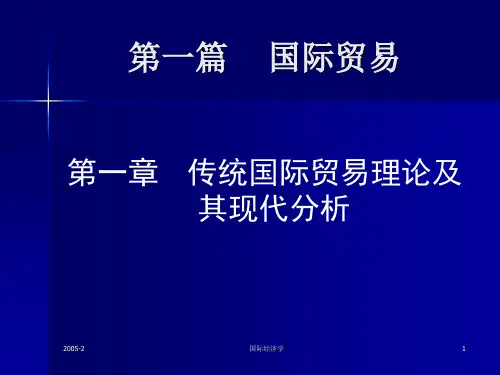
第二章劳动生产率与比较优势李嘉图模型▪各国参与国际贸易的基本原因有两个:•首先,它们在气候、土地、资本、劳动力和技术等方面存在着千差万别。
•其次,它们试图通过贸易来达到规模经济。
▪李嘉图模型以国家间的技术差别为研究基础:•这些技术差别反映在劳动生产率上。
第二节单一要素经济▪假定存在一个经济社会(我们称之为本国),在这个经济社会中:•劳动是唯一的生产要素。
•只生产两种产品(葡萄酒和奶酪)。
•劳动的供给是既定的。
•每种产品的劳动生产率是既定的。
•所有的市场都是完全竞争的。
▪各个产业的劳动生产率表明了本国的技术水平,为简便起见,我们用单位产品劳动投入来表示劳动生产率。
•单位产品劳动投入指一单位产出所需要的劳动时间。
▪aLW表示生产一加仑葡萄酒的单位产品劳动投入。
▪aLC表示生产一磅奶酪的单位产品劳动投入。
▪L为本国的全部资源,即劳动供给。
一、生产可能性边界二、相对价格与供给▪在单一要素模型中,产品的供给是由相对价格与机会成本共同决定的。
▪PC-为奶酪的价格,PW-为葡萄酒的价格。
▪以葡萄酒衡量的奶酪的相对价格为PC/PW。
单一要素模型中不存在利润,因此每小时工资率等于一个工人在1小时内创造的价值。
第三节单一要素世界中的贸易▪模型假设:•在世界上有两个国家:本国和外国•每个国家生产两种产品:葡萄酒和奶酪•劳动是唯一的生产要素•在每个国家劳动的供给是既定的(L,L*)•每种产品的劳动生产率是固定的•劳动在两个国家之间不可流动•市场为完全竞争的•用*来表示外国的变量一、绝对优势和比较优势1、绝对优势Absolute Advantage•当一个国家能够以少于其他国家的劳动投入生产出同样单位的商品时,那么该国在生产这种商品上具有绝对优势。
•假设–这意味着本国在两种产品的生产上均具有绝对优势。
也就是说和外国相比,本国在两种产品的生产上效率更高。
–即使本国在两种产品上均具有绝对优势,互惠贸易也是由可能发生的。
贸易模式是由比较优势决定的。